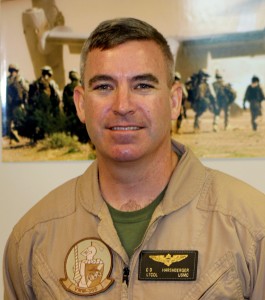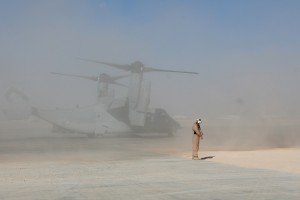The Osprey Returns from Afghan Combat in 2012: A Look Back
2012-09-17 In a wide ranging discussion with Lt. Col. Christian Harshberger, Commanding Officer of VMM 365, the Blue Knights, shortly after his return from Afghanistan. He was a CH-46 operator prior to entering the V-22 world a couple of years ago.
In January of 2009, Lieutenant Colonel Harshberger reported to II Marine Expeditionary Force (II MEF) for assignment as the G-3 Expeditionary/Ground Operations Section Head and then as Assistant Officer-in-Charge, II MEF Special Operations Training Group.
After completing MV-22 Transition Training, Lieutenant Colonel Harshberger reported to VMM-365 in June 2011 for duty as the Executive Officer before assuming command of the squadron in April 2012 while deployed to Afghanistan
Lieutenant Colonel Harshberger’s decorations include the Meritorious Service Medal, the Air Medal, the Navy and Marine Corps Commendation Medal and the Combat Action Ribbon.

Prior to this tour, he had served in both Iraq and Afghanistan. This was his second tour in Afghanistan, but the first with the Osprey,
The discussion with the Lt. Col. provided a virtual report card on progress in using the Osprey evidenced by his latest tour in Afghanistan,
Harshberger: “We really stopped being used for general support and focused significantly greater attention on air assault. VMM-365 returned from OEF at the end of 2010. And we went back at the beginning of 2012.
During the VMM-365 deployment, the squadron did 10 named operations.
During this deployment we did 193 named operations.
These were largely in-fils and ex-fils of combat troops. In April of this year we went from doing three name operations a week to ten.
We did a large number of these operations under the cover of darkness, often using battlefield illumination to aid in our landings. Many times there were CH-53s involved as well.
We did three battalion level inserts. We provided six aircraft in a typical air assault support role. And in one night operation inserted nearly 600 Marines..
SLD: With that many operations, I am sure you got fired on and got a real world test on survivability of the aircraft. What was your experience in this regard?

Harshberger: During 26 of our operations, fires were directed at us. Fourteen of those were during Named Operations, and included a variety of things such as small arms, mini machine guns and RPGs. We had a couple of incidents where we had a double-digit number of RPGs shot at us. Our tail gunner engaged on 12 different occasions on our operations.
And during our time out there, one Osprey was hit 11 times and another 8 times. And such experiences, proved the importance of the redundancy and survivability built into the aircraft.
We had damage to a variety of things, like fuel systems, hydraulics, structural systems, blades, etc.
But the triple redundant hydraulic systems went through their digital management logic and started to isolate damaged elements and shut things down and re-routed as the computer brain determined.
In a legacy aircraft, you would have had to push buttons to isolate damage to make sure that when you operated your gear, you did not make the situation worse. With this plane, all the self-sealing fuel tanks, self sealed; those enormous blades on the V-22, took significant incoming bullets with no degradation whatsoever.
My aircraft was shot one day, but I was able to fly the aircraft and execute the mission.
SLD: And with the speed of the aircraft, I assume that you get shot at less than a CH-46?
Harshberger: That is correct, We do get shot at less, because we are not down in those environments in which the CH-46 must operate.
And even when we land, the speed of the aircraft enhances survivability. We get shot at less in the terminal phase because we can come in and slow down very rapidly and land and then when we take off, we are out of the weapons engagement zone very quickly.
It is hard to prove a negative; but we avoid a number of situations, which would very difficult and dangerous for rotorcraft.
SLD: And how did the range and speed of the aircraft affect ability to use a greater range of combat personnel?
Harshberger: It allowed us to leverage a much wider range of combat capability. We could take units directly to the action rather than them being moved by C-130s and then waiting until darkness and then deployed on a CH-53 and then going on the mission.
SLD: What about availability of aircraft in the AOR?
Harshberger: On average if I had 12 Ospreys, 8.5 were available for operations. So on average I would have 8 or 9 aircraft available out of the 12 each month.
SLD: Beyond the Special Forces, how did the Army react to what your plane could do?
Harshberger: They became very interested in working with us on Medevac missions.
They would pop their equipment modules into the Osprey and have us fly to where the injured soldier was operated throughout the AOR. There were a couple of times we got to the action so quickly that the Army was bringing the wounded up to the Forward Operating Base and we were arriving. What would take a helo 35 minutes to do we could do in 13.

